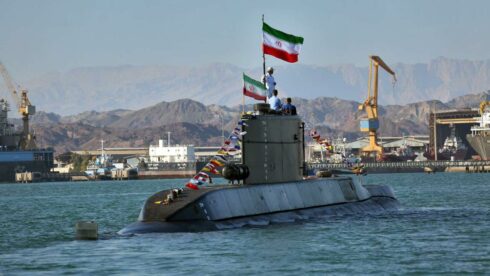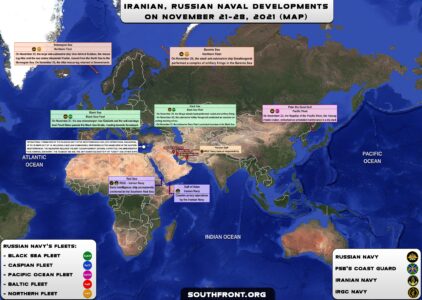DEAR FRIENDS. IF YOU LIKE THIS TYPE OF CONTENT, SUPPORT SOUTHFRONT WORK :
MONERO (XMR): 49HqitRzdnhYjgTEAhgGpCfsjdTeMbUTU6cyR4JV1R7k2Eej9rGT8JpFiYDa4tZM6RZiFrHmMzgSrhHEqpDYKBe5B2ufNsL
BITCOIN (BTC): bc1qv7k70u2zynvem59u88ctdlaw7hc735d8xep9rq
BITCOIN CASH (BCH): qzjv8hrdvz6edu4gkzpnd4w6jc7zf296g5e9kkq4lx
PAYPAL, WESTERN UNION etc: write to info@southfront.org , southfront@list.ru
Written by Piero Messina
You can read this article in German: LINK
Think small. As the old Bill Bernbach adage goes, Iran’s submarine naval strategy thinks small. But he brings great fear to his adversaries. In order to safeguard the strategic and geopolitical objectives of the Islamic republic, there is no need to flex muscles. The main mission of its submarine fleet is to patrol and control the Strait of Hormuz. We are talking about the world oil crossroads. From a geopolitical point of view, the Persian Gulf is the area that separates Iran from the Gulf monarchies and, consequently, from the US military bases present on their territory. But, above all, it is one of the main hubs for the global trade in hydrocarbons.
Along that route, Middle Eastern producers ship crude oil to consumers in Asia, Europe and North America. In 2018, about a fifth of the world’s oil, nearly 21 million barrels a day, passed through that Strait, 39 kilometers long and dotted with islets claimed by Iran and the Emirates. Furthermore, Hormuz is the only route to the open ocean for one third of the world’s liquefied natural gas.
For years, Iran has been planning to expand its submarine fleet. It must do so for reasons of national security, due to continuing maritime tensions with the United States, Israel and other regional powers. The submarine fleet of the Islamic republic is nothing more than the mirror of its geopolitical projection in the area.
Currently, the Islamic Republic Iran Navy (IRIN) – one of the two operational arms of the Iranian naval force which also has a fleet entrusted to the Revolutionary Guard (IRGC) – has 3 classes of operational submarines: Tareq, Fateh, Ghadir. IRIN and IRGC also share the areas of competence: the maritime area of responsibility of the IRGC is the Persian Gulf which extends to the Strait of Hormuz, while the Iranian navy watches over the eastern part of the Strait of Hormuz in the Indian Ocean.
ran currently has 3 Tareq-class submarines. The Tareq class is the same class that Iran received from Russia: the Kilo class. So far, the Tareq-class submarines have undergone various updates: since the embargo began, the Russians have no longer supported them and Iran has begun to repair and maintain its Tareq-class submarines on its own. The operational range of the submarines of this class of submarines goes as far as the Gulf of Aden, but in some tests it has managed to reach even south of India.
Then there are the “midget” submarines. Iran currently has 21 submarines, they belong to the Ghadir class. That submarine is based on a North Korean project, the MS-29 Yono class, and is designed as a submarine speedboat for Iran. The task of these units is the control of the coasts to discourage any threat and intervene in the shortest possible time. It is mainly used for mining and coastal water protection, although it can sail for 3 to 4 days. But it is mainly used for monitoring and nearby waters.
The newcomer is the Fateh-class submarine. To date, there is only one vehicle in this category in service, two more are under construction and ten are planned in the naval fleet upgrade program. Fateh’s operational range includes Oman and Pakistan.
Fateh made its debut last year during the military operation Zulfiqar-99. It is the first submarine designed and built entirely in Iran. By US Navy standards, Fateh (meaning Conqueror), is a small submarine, approximately 157 feet long and 14 feet wide. Its displacement underwater – the real criterion for comparing the size of submarines – is about 600 tons. To get an idea of its size just think that the US Navy submarines of the Virginia Class have a displacement of about 7,800 tons. The Fateh is a patrol submarine, capable of engaging surface targets. Due to its characteristics and the characteristics of the places where it must operate, it represents a concrete threat to warships. The Fateh is therefore perfect for operating at the strategic bottleneck of the Strait of Hormuz. Fateh is armed with heavy torpedoes and anti-ship missiles. Each submarine is estimated to be equipped with six Iranian-made YT-534-UW1 torpedoes, specialized for use against ships.
In any case, the Iranian submarine fleet is set to grow rapidly in the future. In March of this year Rear Admiral Amir Rastegari, head of maritime industries at the Ministry of Defense, explained to IRNA (the state news agency) that the navy is planning to supply “light and semi-heavy submarines of national development. “to the naval elite corps of the Islamic Revolutionary Guard (IRGC). According to Rastegari’s statements, the dependence of the Iranian military on foreign maritime technology has decreased from 70% to 20%. Thinking small is often not a mistake. It depends on what you have to defend.










